How much does SD-WAN cost?
The cost of implementing SD-WAN varies widely based on several factors, including bandwidth requirements, deployment model, features, and functionalities.
Each organization has unique needs, so there’s no uniform cost. Understanding both initial and ongoing expenses helps in accurately estimating the total price of an SD-WAN solution.
What are the cost factors of SD-WAN?
The cost factors of SD-WAN (software-defined wide area network) include network bandwidth requirements, features and functionality, deployment model, scalability and capacity, security, service and support, resiliency, and equipment.
Each plays a significant role in determining the total expenditure for an SD-WAN solution. By carefully analyzing these factors, organizations can better plan and allocate budget for a cost-effective SD-WAN implementation.
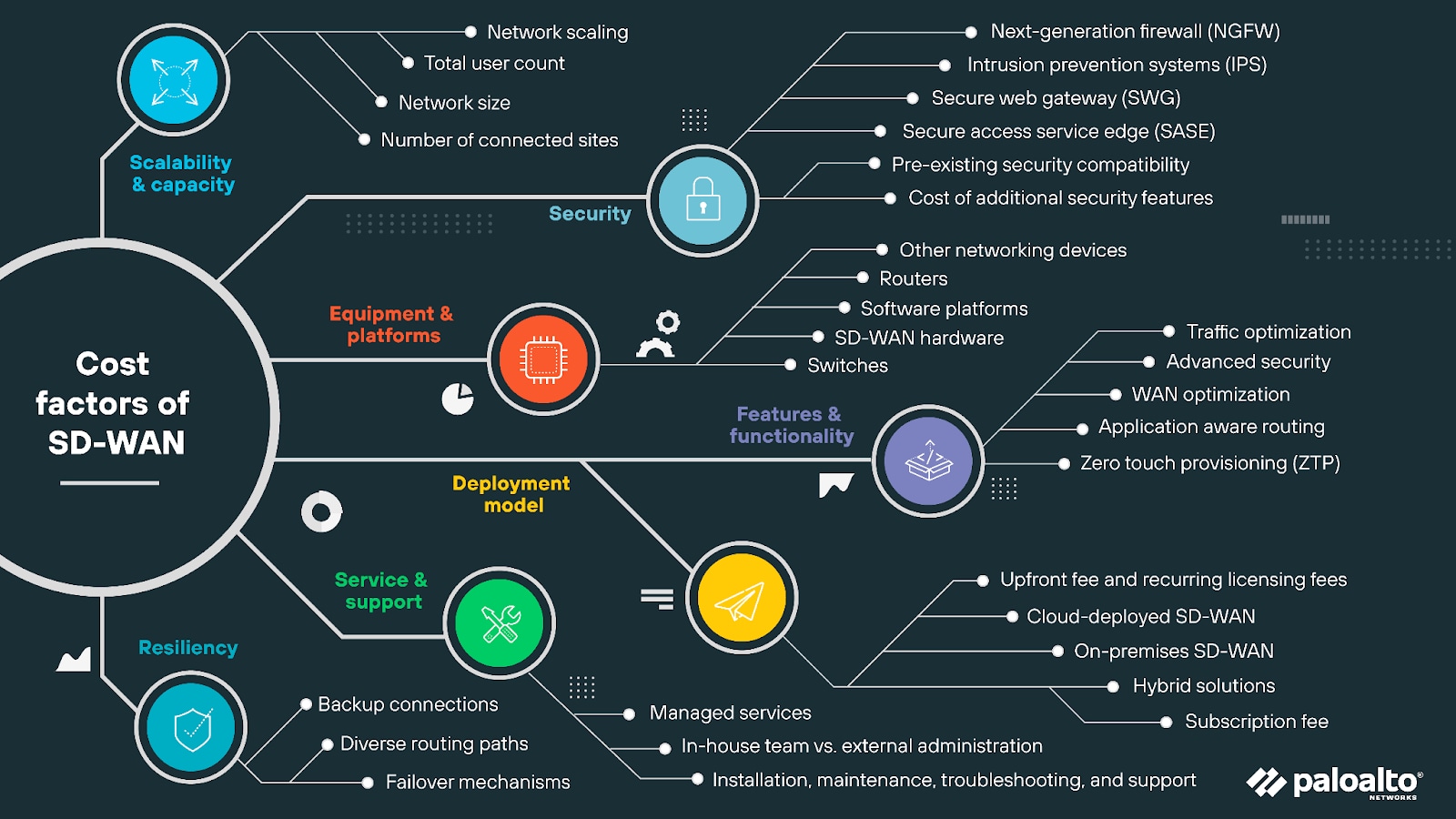
Network bandwidth requirements
Network bandwidth requirements significantly impact SD-WAN costs.
For example: In the U.S., basic broadband can cost as low as $30-$50 per month, while high-speed dedicated ethernet can exceed $1,000 per month.
When considering SD-WAN solutions, it’s important to understand your business’ network bandwidth requirements.
Don’t forget to factor in the current underlay, and which SD-WAN vendors can best optimize your communication links. Considering all bandwidth factors will help you identify the right solution.
Features and functionality
SD-WAN solutions vary significantly in terms of features and associated costs.
Basic SD-WAN offerings typically focus on standard traffic optimization—which is a cost-effective solution for businesses with straightforward networking needs.
More advanced SD-WAN solutions come with a broader array of features like WAN optimization, application aware routing, and zero touch provisioning (ZTP). But higher-end solutions that incorporate advanced capabilities are also more expensive.
Deployment model
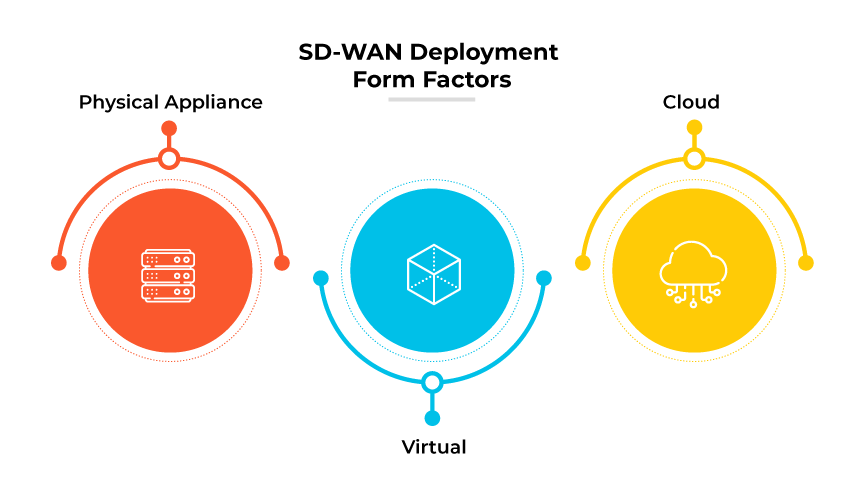
The choice of deployment model significantly impacts the overall cost of SD-WAN, depending on the vendor and specific needs of the business.
Some SD-WAN vendors differentiate their offerings by offering cloud-based deployment, which typically comes with a subscription fee. This model allows businesses to access SD-WAN capabilities without significant upfront investment in hardware.
In contrast, on-premises SD-WAN solutions usually involve a higher initial fee for SD-WAN appliances and installation, followed by lower recurring licensing fees.
Hybrid solutions combine elements of both models, offering a balance between upfront costs and ongoing expenses.
Scalability and capacity
The scalability and capacity of solutions also majorly influence SD-WAN business costs. The size of the network, number of connected sites, and total user count are key factors.
Cost-effective solutions are available for varying user counts and scaling needs. For fixed user/device numbers, a pay-as-you-go model may help manage costs—which are usually lower for smaller scales. Note that pay-as-you-go models can be more expensive to scale compared to variable solutions.
Tip: Always factor in the potential for future growth when determining the scalability and capacity requirements of your SD-WAN solution. To optimize costs effectively, you need to balance current needs with long-term objectives.
Security
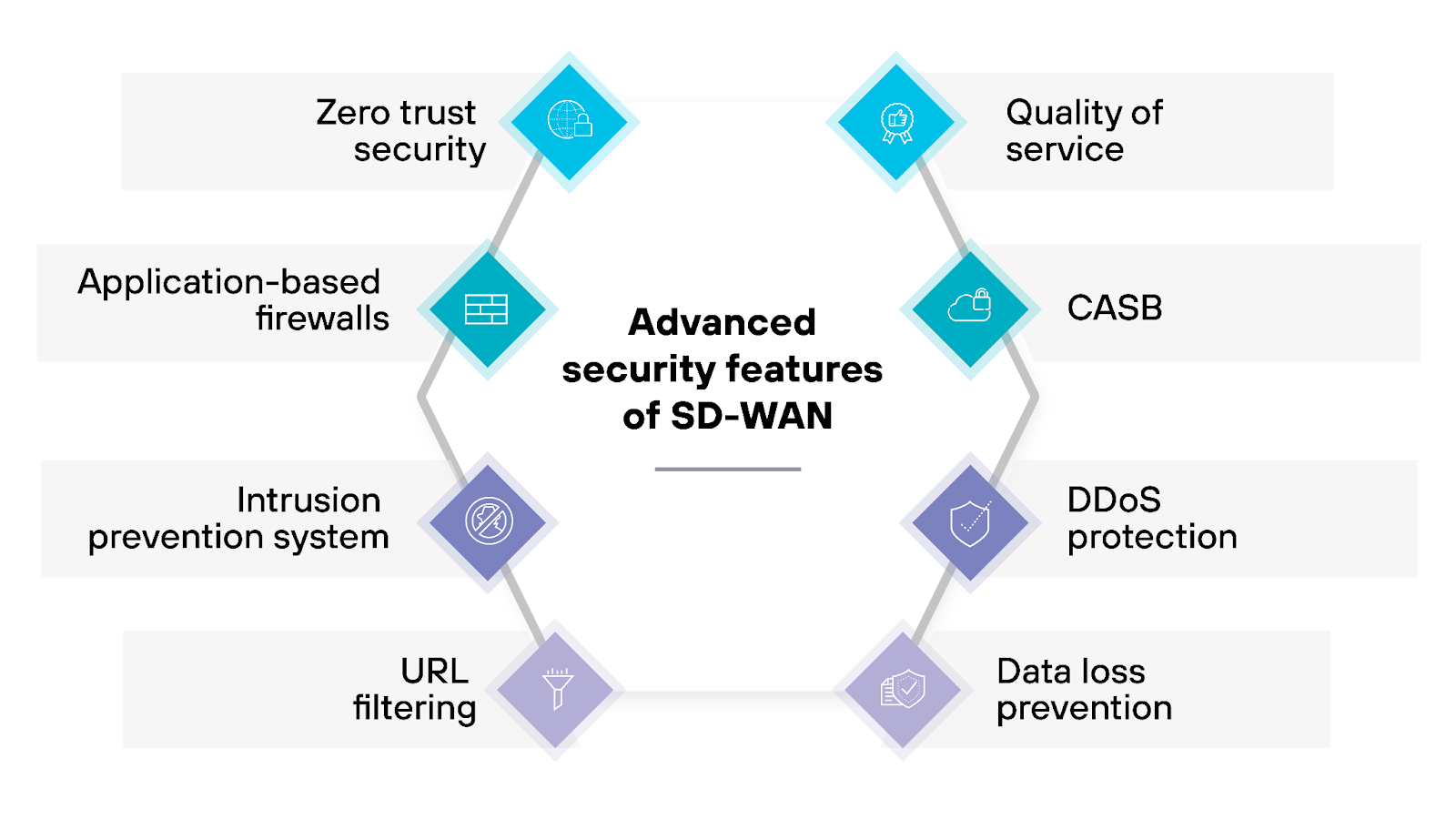
Modern SD-WAN solutions typically include advanced security features like next-generation firewall (NGFW), intrusion prevention systems (IPS), and secure web gateway (SWG). These features add to the overall cost.
Plus: Integrating secure access service edge (SASE) or security service edge (SSE) incurs further expenses.
Evaluating existing security infrastructure can help manage SD-WAN costs. If pre-existing security appliances are compatible with the SD-WAN vendor's offerings, you can reduce some of the security expenses.
Service and support
Service and support are critical aspects of SD-WAN infrastructure management. When technical issues arise, it can be challenging for businesses without a dedicated in-house team.
Many SD-WAN vendors offer managed services, including:
- Installation
- Maintenance
- Troubleshooting
- General support
However, managed services come with higher costs. Carefully evaluate your organization’s network administration competency to determine whether managed services are necessary.
Resiliency
Ensuring network resiliency and redundancy is crucial for maintaining continuous business operations. Especially in the event of network failures.
But implementing resiliency measures usually requires further investments in backup connections, diverse routing paths, and failover mechanisms.
These measures do increase costs, but they’re essential for preventing downtime and maintaining service continuity. Which adds up to saving money by avoiding disruptions.
Equipment and platforms
The cost of SD-WAN technology equipment includes expenses for hardware, software platforms, and any necessary physical or virtual appliances.
Businesses need to budget for initial hardware purchases, which may include routers, switches, and other networking devices.
Don’t forget: Software licensing and updates are recurring costs.
Further reading: SD-WAN vs. SASE: What’s the Difference?
Which SD-WAN pricing models do vendors offer?
When it comes to pricing SD-WAN services, vendors offer several models to fit various business needs. Each pricing model caters to different usage patterns, feature requirements, and budgeting preferences.

Subscription-based
Subscription-based pricing charges regular fees for licensing the SD-WAN solution. This model commonly includes support services as part of the subscription.
It’s ideal for businesses looking for consistent support while spreading costs over regular periods. Regular fees make budgeting easier and provide predictable expenses.
Bandwidth-based
Bandwidth-based pricing is another common model in the SD-WAN market.
This approach charges based on the amount of bandwidth used. More bandwidth generally allows for more users or heavier network traffic.
A bandwidth-based model can be cost-effective for businesses with lower bandwidth needs because it helps keep expenses manageable.
Pay-as-you-go
Pay-as-you-go pricing is based on actual SD-WAN usage.
This is a more flexible model that often works well for businesses with fluctuating network consumption, like seasonal operations. It allows companies to reduce costs during quieter periods and scale up as needed without a long-term commitment.
Note: This is distinct from bandwidth-based pricing, which charges based on the amount of bandwidth used. Pay-as-you-go pricing charges based on actual SD-WAN usage, offering flexibility for fluctuating network demands.
Feature-based
Feature-based pricing involves charging for additional features beyond the base SD-WAN solution. Businesses can select and pay for only the features they need, such as advanced security or WAN connection optimization.
This model can be cost-effective for organizations that don’t need a full suite of features, allowing for customized, scalable solutions.
Tiered pricing
Tiered pricing offers different service levels at set price points. Each tier includes specific features or bandwidth limits.
Tiered pricing is suitable for organizations with diverse SD-WAN requirements across different locations. It allows businesses to choose a tier that fits their needs and budget, providing flexibility and control over costs.
Per-site pricing
Per-site pricing is determined by the number of connected sites. It simplifies budgeting and allows for predictable expenses per site, making it easier to manage network costs across various branches.
This model is ideal for businesses with multiple locations because costs are based on the number of sites rather than overall usage.
Flat-rate pricing
Flat-rate pricing offers fixed fees for SD-WAN services, regardless of usage. The model simplifies budgeting by providing a consistent cost structure.
It’s beneficial for businesses that want to avoid variable expenses and prefer a predictable monthly or annual fee.
Flat-rate pricing can often be more expensive than variable models but offers stability and simplicity in financial planning.
How does SD-WAN reduce networking costs?
SD-WAN can reduce networking costs by replacing expensive MPLS circuits with low-cost broadband connections, streamlining network management through centralized control, and consolidating multiple functions into single devices.
Plus, SD-WAN increases operational efficiency and security, which together reduce the need for extensive technical support.
It also minimizes downtime.
These outcomes collectively contribute to substantial SD-WAN cost savings for businesses.
Note: While it’s true that SD-WAN can help organizations save money on network costs, savings aren’t always guaranteed. The cost of MPLS networks and diverse broadband options vary by location. Plus, initial investments can be substantial, and network complexity along with ongoing management costs can offset savings.
Lower transport costs
SD-WAN reduces transport costs by using low-cost broadband connections instead of expensive MPLS circuits. SD-WAN also allows businesses to use a mix of connection types.
Operational efficiency
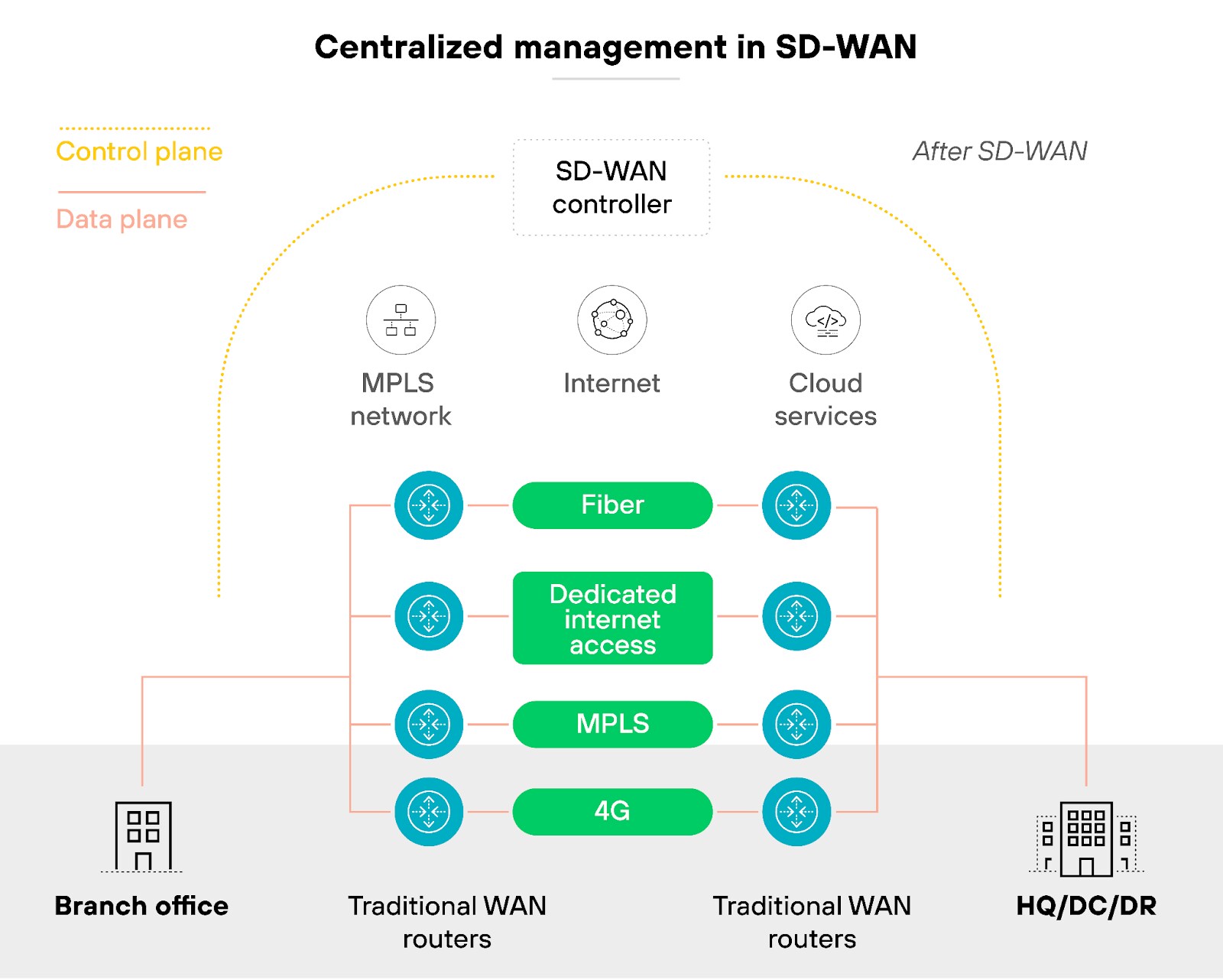
SD-WAN enhances operational efficiency through centralized management and software-defined controls. This reduces the need for manual configurations and site visits, cutting down on labor costs and minimizing human errors.
Additionally, SD-WAN simplifies network management. Which makes it easier for IT teams to maintain and update the network.
Zero-touch provisioning further reduces costs by enabling quick deployment of SD-WAN resources without the need for on-site technicians.
Device consolidation
SD-WAN consolidates multiple network functions into a single device. This lessens the need for separate hardware for routing, security, and WAN optimization.
Consolidation also simplifies network architecture, which means lower maintenance and support costs.
Enhanced security
SD-WAN offers enhanced security features, including secure access service edge (SASE) to deliver real-time cybersecurity solutions from the cloud.
Improved security helps prevent costly breaches and downtime, providing another layer of cost reduction.
Higher network performance
SD-WAN improves network performance by automatically, dynamically sending traffic along the most appropriate path based on circuit costs, security conditions, and service quality requirements.
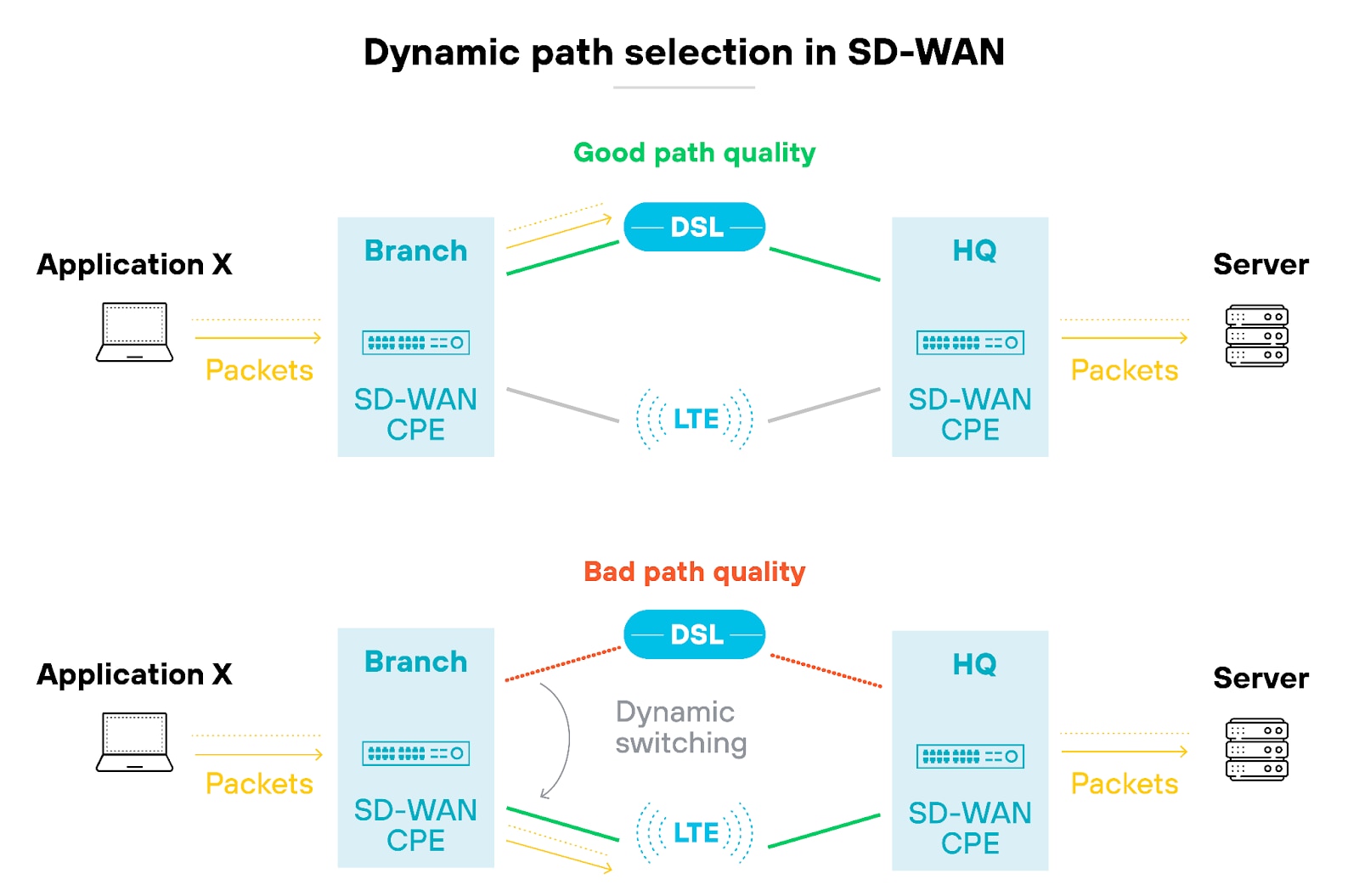
This improves latency and packet delivery speeds. Which in turn enhances application performance and increases staff productivity.
Overall higher efficiency translates into SD-WAN cost savings through better utilization of network resources.
Long-term return on investment
Over time, SD-WAN solutions prove cost-effective by increasing the reliability of connections and reducing the total cost of ownership.
Managing wide-area networks becomes simpler and more flexible, allowing for remote adjustments to meet changing business needs. The long-term efficiency delivers a better return on investment and continuous cost savings.
Further reading: What Is the Difference Between SD-WAN and MPLS?

How to estimate SD-WAN costs
There are many elements to consider when estimating the overall cost of an SD-WAN solution. Since all organizations have unique requirements, there isn't a single price that applies to everyone.
By establishing a clear understanding of both the initial and ongoing expenses associated with an SD-WAN solution, you can arrive at a more accurate cost estimate.
Here are the areas to consider before finalizing your SD-WAN project budget:
Network infrastructure and access
- What is the current network size at each location?
- How many locations and data centers are there?
- Where are the endpoints for each service (e.g., office branches, manufacturing facilities, agent locations, home offices)?
- How many users will there be at each location after the planned network migration?
- What applications will be used across the network? Are these bandwidth-intensive, and what bandwidth is needed for optimal performance?
- Are there any internet connectivity and/or access issues to consider?
- Do you have hubs in AWS, Azure, or other IaaS Clouds?
- Do you anticipate the company will grow and add more locations?
- Do you currently use cloud applications or infrastructure?
- Are you planning to migrate to the cloud soon?
Understanding the current network size, scope, and access requirements is crucial for determining accurate SD-WAN cost estimates.
This includes the number of locations and data centers, as well as the presence of any hubs in cloud environments like AWS or Azure. As noted, anticipating future growth and the addition of new locations can also influence your SD-WAN strategy and budget.
By assessing the network size and endpoints at each location, businesses can determine the necessary hardware and connection costs. Evaluating the number of users and bandwidth needs for applications helps identify the required network capacity and performance expenses.
Note that companies that already use cloud applications or have infrastructure set up for WAN may find the transition smoother and less expensive.
On the other hand, businesses planning to migrate to the cloud or make significant upgrades soon will face higher initial costs.
Addressing any connectivity or access issues ensures a comprehensive view of potential infrastructure needs. Which leads to a more precise cost estimate for the SD-WAN solution
Core SD-WAN infrastructure
- Is your infrastructure currently set up for WAN connections?
- Which locations need devices, and in what sizes?
- What security appliances are required at each location?
- How will the equipment be deployed and supported at each location?
- Do you want to CAPEX the equipment or pay for a service every month?
- Will you manage the infrastructure yourself or use an external partner?
- Who will maintain, control, and optimize policies for network functionality?
- What about spares in the event of an infrastructure outage?
These questions help determine costs by clarifying the SD-WAN infrastructure requirements.
Identifying device needs, security appliances, and deployment methods provides a basis for hardware and installation expenses. Deciding between CAPEX or monthly payments and whether to manage infrastructure in-house or externally impacts ongoing costs.
And planning for maintenance, policy optimization, and spares for outages ensures all potential expenses are covered, leading to a comprehensive cost estimate.
Security infrastructure
- Will the SD-WAN integrate with the overall security architecture of the organization?
- Does the pricing include on-site support services?
- What centralized security infrastructure will operate in the core?
- Will remote locations have any security appliances deployed?
- Will remote users need upgraded or different endpoint security software?
- Who will monitor, manage, or maintain these security policies to ensure ongoing security and compliance?
Considering the integration of SD-WAN with existing security infrastructure is crucial because it impacts both initial setup and ongoing operational costs.
Incorporating on-site support, centralized and remote security appliances, and upgraded endpoint security software for remote users adds layers of expense.
Also, effective monitoring and management of security policies are essential to prevent breaches and ensure compliance. All of which contribute to the overall cost of the SD-WAN implementation.
Service management
- Will the service be managed by in-house staff or an external provider?
- Who will users contact for support in case of difficulties?
- If using a Managed Service agreement, what is the SLA?
- Will there be zero-touch deployments or use of an SD-WAN orchestrator tool? What is the monthly cost to run the service?
- How long is the contract term, and are there performance penalties for outages or poor performance?
Service management significantly impacts the overall solution's cost. An incomplete or poorly deployed SD-WAN solution can end up costing more than the network service it replaced. Answering these questions helps ensure a successful SD-WAN deployment and highlight opportunities for cost reductions in TCO analysis.
Employee access and mobility
- Do you have employees who work remotely or are mobile and need to access the network?
- How frequently do mobile employees need to access the network?
- Are your various locations in constant contact with one another? Is this necessary?
- How spread out are your locations?
Employee access and mobility are critical factors in determining SD-WAN costs.
If your workforce includes remote or mobile employees, you need to ensure they can securely access the network from various locations. The frequency of network access and the need for constant communication between locations will affect your network's performance requirements.
Note: The geographical distribution of your locations can influence the complexity and cost of implementing an SD-WAN solution that meets your network connectivity needs.
Data and applications
- Does your company have a lot of sensitive data?
- What is the format of the data?
- How much data flows across your network regularly?
- What is the current speed of data transmission?
- Do you have applications you would like to prioritize or restrict over others?
The nature and volume of data and applications running on your network impact SD-WAN costs.
Sensitive data may require additional security measures. Plus, bandwidth-intensive applications can affect your network's performance and pricing.
Understanding your data flow, transmission speeds, and application prioritization helps accurately estimate SD-WAN costs that meet your performance and security requirements.
How do emerging market trends impact SD-WAN pricing?

Emerging market trends impact SD-WAN pricing by driving both cost reductions and enhancements in service offerings. By staying informed of market dynamics, companies can better navigate pricing models and technological advancements.
Here are some key trends that impact the market costs of SD-WAN technology:
Increased competition
As SD-WAN adoption grows, the market sees more competition among service providers. Competition drives down prices as vendors strive to offer more attractive packages. Businesses benefit from better pricing options and enhanced features as providers look to gain a competitive edge.
Innovation and technology advancements
Innovation in networking technology also influences SD-WAN pricing.
Integrating artificial intelligence, automation, and advanced security features into SD-WAN solutions improves network performance and efficiency, which can lead to initial higher costs.
It’s worth noting, though, that advancements can also offer long-term savings because enhanced capabilities tend to reduce operational expenses.
Scalability and flexibility
The demand for scalable and flexible SD-WAN solutions is rising. Businesses need networks that can grow with them and adapt to changing needs. Scalable solutions may have higher upfront costs but reduce long-term expenses by avoiding frequent network overhauls.
These parameters directly influence SD-WAN market pricing as businesses seek solutions that balance initial investments with future scalability.
Cloud adoption
The shift to cloud-based services impacts SD-WAN pricing.
As more businesses migrate to the cloud, the demand for robust, cloud-compatible SD-WAN solutions increases. This trend can lead to cost increases because of advanced features, and cost reductions, thanks to streamlined operations and better resource utilization.
Security enhancements
Security is non-negotiable for modern networks. The need for enhanced security features in SD-WAN solutions drives up costs. However, investing in advanced security also helps prevent costly breaches and downtime, leading to overall cost savings.
Fluctuations in bandwidth pricing
Bandwidth pricing is subject to market fluctuations. As bandwidth costs change, SD-WAN pricing adjusts accordingly. Understanding these trends helps businesses budget more effectively and take advantage of lower bandwidth costs when available.
Vendor pricing strategies
Vendors continually adjust their strategies to stay competitive, offering various models like tiered pricing, subscription plans, and pay-as-you-go options. Flexible pricing models aim to attract different business needs and financial capacities.
By providing tailored, flexible pricing structures, SD-WAN vendors accommodate diverse usage patterns and budget constraints, which impacts the overall market prices.
Further reading:
- What Is Next-Generation SD-WAN?
- How Does SD-WAN Automation Simplify Network Operations?
- What Is SD-WAN Multicloud?
- Why ML and AI Are Key Technologies for SD-WAN
Is SD-WAN worth it?
SD-WAN is well worth it for businesses with multiple locations and/or a significant need for scalable, flexible, and efficient network management. It’s a great cost-saving tool because, as explained, SD-WAN reduces reliance on pricy MPLS circuits, plus it optimizes network management.
On the other hand, it’s important to understand that SD-WAN may not be the best choice for businesses with simple networking needs—or those located in regions where the cost of high-bandwidth internet is prohibitive. In these scenarios, the initial setup and ongoing management costs can outweigh the benefits.
Essentially, SD-WAN is a great option for businesses who will benefit from its capabilities, but it may not be cost effective for those whose network requirements don’t justify the investment.


